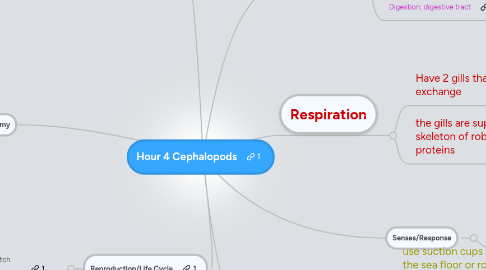Hour 4 Cephalopods
by Karla Lockman


1. Anatomy
1.1. Head-like skin structure called the Mantle which takes up most of the body Eyes Mouth Arms and tentacles - arms are for holding food and tentacles are longer for catching it; tentacles in squid and Octopie also have poison to catch their prey with. Parrot-like Beaks for biting into food. Radula for cutting up food Stomach Gills - filtering water for oxygen to breathe Internal shell for structure Heart Gonad Siphon - intake and outake of water Brain Ink sac - specialized for escape and defense, as well as a weapon to blind predators Cuttlefish have a Cuttlebone; inner shell Kidney Anus - for excretion Crop Squid and Octopie have poison glands.
2. Reproduction/Life Cycle
2.1. a short life span some have 3 to 15 months. All hatch from eggs most in 3-5 months. They all lay eggs individually. They can all lay up to 1, 000 eggs at a time.
3. Circulation
3.1. Squids have a closed circulatory system and they use hemocyanin, a copper-containing protein, rather than hemoglobin, to transport oxygen.
3.2. Blood is colorless when deoxygenated and turns blue when exposed to air. Squid and Octopus have blue blood.
3.3. A single systemic heart pumps the oxygenated blood through the rest of the body.
4. Feeding/Digestion
4.1. Feeding: shrimp, small fish, small crustatians
4.2. Octopus Feeding: worms and other cephalopods
4.3. Digestion: digestive tract
5. Senses/Response
5.1. eyes
5.1.1. tentacles
5.1.1.1. skin/shell
5.1.1.1.1. highly developed eyes but poor lens
6. Movement
6.1. use suction cups on their arms/legs to stick on to the sea floor or rocks, swimming, push themselves, move around and grab food.
6.2. Jet Propulsion - a method use to swim fast
6.2.1. -water taken into mantle cavity by expansion of the mantle and shoot out from the hyponome
